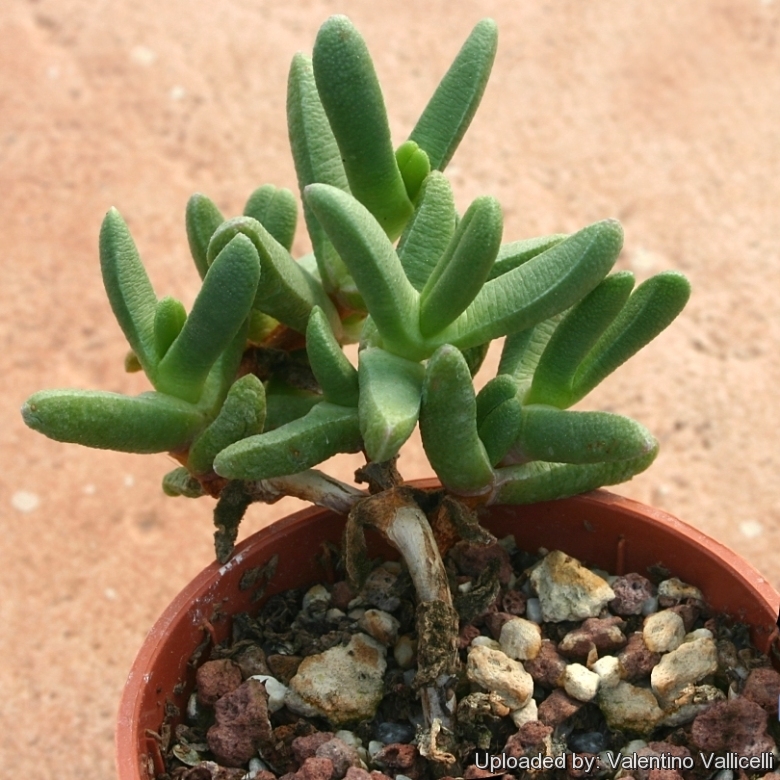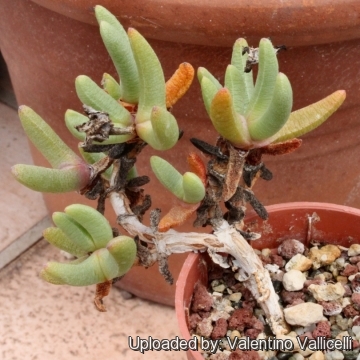
Peersia macradenia Photo by: Valentino Vallicelli
Origin and Habitat: Succulent Ceres Karoo (Tanqua), Northern Cape Province and Weatern Cape Province (Distr Ceres, Laingsburg, Prince Albert) South Africa
Altitude: 600–1200 metres above sea level.
Habitat: The plants occur from the proper winter rainfall zone into the March and March / November rainy season, they grow on desert paved areas on flat and rough shale bands in a very open dwarf shrub sub-community along with other succulents such as: Herereroa fimbriata, Antimima hantamensis, Malephora crassaSN|20940]]SN|20940]], Ruschia spinosa, Cheiridopsis acuminata and conserves moisture in their succulent leaves. Annual precipitation is approximately 100-200 mm, mostly in winter. Annual Asteraceae covers the sparsely vegetated ground after good winter precipitations while short-lived annual mesembriamthems colonize the more sodic sites.
Synonyms:
Description: Peersia macradeniaSN|19563]]SN|19563]] formely known as Rhinephyllum macradeniumSN|19561]]SN|19561]] is a small succulent developing into a compact caespitose cushion up to 25 cm tall with thin fingerlike-leaves and bearing small yellow flowers.
Distinguishing characteristic: The combination of almost terete leaves with a rather abrupt acute tip and the differences in the sizes of the calyx lobes characterize this species.
Stem: Short, woody, branched with the remnants of old dry leaves.
Leaves: Fleshy, in annual increments of 2-3 (or more)decussate pairs, almost free at the base, trigonous, acuminate, (i.e. Narrowing to the pointed tip only in the upper part of the leaf), semi-terete below, about 25-60 mm long, 6-8 mm broad, smooth, green to silvery green.
Flowers: Opening in the evening, solitary, daisy-like more than 2 cm in diameter, with the 2 outer taller calyx lobes distinctly bigger than the other three. Petals yellow.
Fruits: The fruit is a 5-locular capsule with valve wings broad, almost parallel to the sides of the valves, but tapering to the base, septa without or with very narrow ledges.
Seeds: Light brown, smooth, with testa cells raised over the entire seed.
Notes: Two former Rhinephyllums have been reclassified into the genus Peersia, Rhinephyllum frithii as Peersia frithii, Rhinephyllum macradenium as Peersia macradenia. These have smooth leaves, unlike Rhinephyllums proper.
Bibliography: Major referenses and further lectures
1) Heidrun E. K. Hartmann “Illustrated Handbook of Succulent Plants: Aizoaceae F-Z” Springer, 2002
 Peersia macradenia Photo by: Valentino Vallicelli
Peersia macradenia Photo by: Valentino VallicelliSend a photo of this plant.The gallery now contains thousands of pictures, however it is possible to do even more. We are, of course, seeking photos of species not yet shown in the gallery but not only that, we are also looking for better pictures than those already present.
Read More... Cultivation and Propagation: The Rhinephyllum macradeniumSN|19561]]SN|19561]] (Peersia macradeniaSN|19563]]SN|19563]]) is a "winter" grower which is most active from late winter until later spring and heading for summer dormancy, but can otherwise be grown as normal mesembs and if water is available it doesn't go dormant in summer. It is relatively easy to grow, but more forgiving than other Mesembs of excess water.
Soil: Requires good drainage as it is prone to root rot. It can grows outdoor in sunny, dry, rock crevices (protection against winter wet is required) It can also be cultivated in alpine house, in poor, drained soil. A mixture comprising 20 % pumice grit, 20% lava grit, 20% quartz grit, 20% coarse river sand and 20 % garden soil seems well suited.
Fertilization: Fertilize moderately during the growing season with diluted high potassium fertilizer.
Watering: Water minimally in summer, water more abundantly when they are growing in the autumn and spring.
Light: It needs a bright sunny or light shade exposure in winter, but keep cool and shaded in summer. With insufficient illumination bodies get thinner as a result of the lack of sun.
Hardiness: It prefer a very bright situation and will take a light frost (Hardy to -5°C) if it is in dry soil. USDA zones 9A-11.
Uses: Container, rock garden.
Propagation: Seed in spring or division of larger clumps. It is easily propagated by seed. Seeds germinate in 7-14 days at 21°C. Although they will start from cuttings, it is quite difficult to get them to root. If they start to rot there is usually part of the plant that can be removed and possibly rooted.











